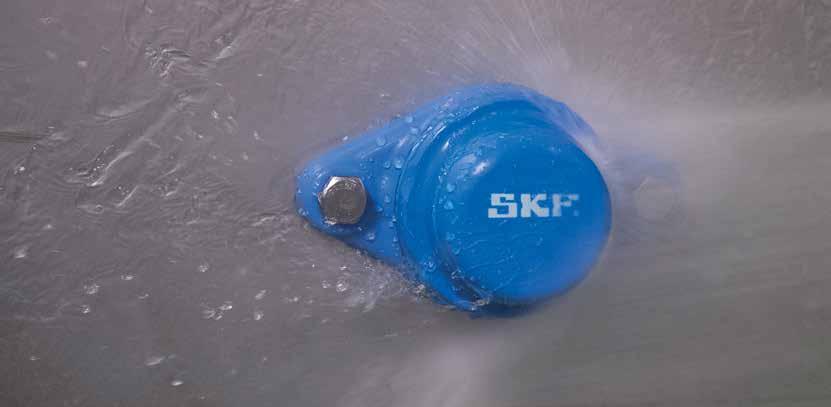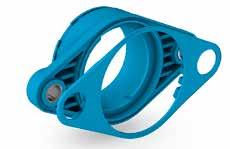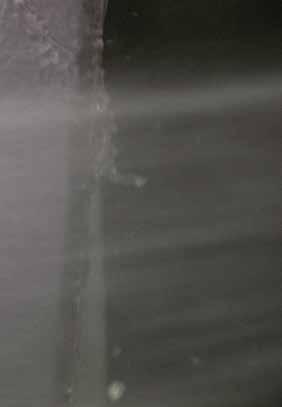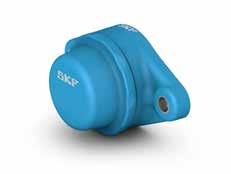
5 minute read
Breaking the Boundaries of Hygienic Bearing Design
David Oliver Channel and Platform Manager
Advertisement
We’re not ones to normally point out the obvious, but maintaining optimal cleanliness is pivotal to reducing food safety risks in manufacturing and production environments. But achieving this isn’t as simple as you first may think. Underlying issues such as contamination of your housed bearings, the problems associated with hygienic design and introduction of relubrication-free technology have given us food for thought and so we decided to rethink our approach. Long gone are the days where stringent washdowns are enough, we must begin to understand every risk and embrace new technologies and methods if we are to reach our risk-free hygiene goals.
Across the globe, the European Hygienic Engineering Design Group (EHEDG) outlines the design standards for food production equipment, with hygienically designed relubrication-free solutions labelled as critical to further reducing safety risks in food production zones. SKF’s innovative Foodline Bearing Units Blue Range has been specifically designed to combat such concerns. Here, we take a glimpse into how SKF has developed this effective EHEDG-compliant bearing system that has the capabilities to withstand regular washdowns without the need for relubrication.
Two parts better than one
For bearings that are frequently exposed to washdown procedures to achieve their expected high performance, the sealing solution is critical.
The cleaning fluid used during washdowns poses the biggest threat to your bearings, given that detergents lower the surface

Over moulded construction offers effective base seal

tension of the liquid, allowing fluids to pass directly through conventional seals. Once inside the bearing, the detergent mixes with the lubricant oils whereby the caustic content of the detergent breaks the grease down. On top of this, high-pressure water or high volumes of process water can also cause emulsification and flush grease away from the bearing. With these problems at the forefront of design, SKF explored a way to turn the behaviour of detergent water into an advantage. The new solution involved a two-part seal design with multiple interlocking flanges that act as ‘gutters,’ with an outer lip protecting the bearing from particles and high-pressure water. Any washdown liquids that bypass the seal are then channelled along the gutter under the influence of gravity, draining away without causing any unwanted damage.
End cover incorporate a positive locking mechanism Covering all bases

But we would like to point out that seals are not the only crucial components in protecting your bearings. In order to limit the ingress of fluids to the bearing cavity, SKF have also designed an end cover with a patent pending locking mechanism, along with effective back and base seals.
The high-performance material of the end cover provides a rigid, protective cover with enough flexibility to form an effective interference seal with the housing. Given the fact that end covers only contribute to hygiene if they remain in place, this specific end cover incorporates positive locking to the housing unit, removing the risk of accidental dislodging. This patented rotating locking mechanism is extremely reliable, whilst also offering engineers easy dismounting without the need for tools when inspection is required. Dynamically sealing against the shaft and statically with the housing, the back seal offers double sealing protection, stopping foodstuffs from entering the bearing cavity. This static seal in particular has a specially designed wave silhouette that provides faultless sealing. Finally, a food-grade rubber is selectively over-moulded with the composite of the housing to create an effective base seal. Moulding the perfect solution
Housing geometry and surface characteristics also have effects on cleanability. Contaminants have a habit of becoming trapped in voids and other spaces, another area that SKF has successfully addressed. Since mechanical loads are usually relatively low in food and beverage applications, SKF decided to use polymer composite housing designs. Such materials can easily be moulded into smooth shapes, creating desirable features such as sloping surfaces. However, designing a moulded housing requires the use of internal or external reinforcing ribs. These types of structures create voids inside the components, inaccessible voids that are difficult to clean and provide the perfect breeding ground for microbial growth – precisely want you need to avoid.
So, to reap the true benefits of moulded housing designs, with minimal disadvantages, SKF investigated the possibilities of overmoulding technology. This different approach required a two-step manufacturing process where you begin by moulding the structural components of the housing, then injecting a second material – in this instance a flexible rubber – to fill the voids within the parts. A polypropylene material, reinforced with long glass fibres was used to deliver the right combination of structural and moulding characteristics. Polypropylene is extremely resistant to chemical attack and unlike nylon, does not absorb water. Under the right moulding conditions, a smooth finish can be achieved, as well as good recyclability at end of life – adding further to its advantages. Up to the test
Pitting the new hygienically designed bearing unit against a conventional re-lubricable unit during a comparative washdown test conducted by RISE, the evidence demonstrated the benefits of hygienic design in cleanability. The results displayed that the new bearings required 30% less water compared to historical designs, largely owing to the elimination of grease discharge. From a performance perspective, the newly designed bearing and sealing system performed well in both in-house testing and when installed on customers sites. Early tests of the bearing insert at one customer plant, where conventional food and beverage bearings previously required replacing every nine months and re-lubricating every 10 days, the bearings using with the new lubricant and seal combination operated reliably for more than 18 months without relubrication.
Assessing the risks at the early possible stage, and identifying new methods to reduce such risks has clearly paid dividends. When discussing the new units following the trial at the customers site, the customer expressed their delight at the results and did not wish to remove from operation and return to SKF for analysis. Certainly a positive step forward.











